Producers must continually adapt to changing customer expectations, technological advancements, regulatory changes, and the disruptive impact of new market entrants. However, data underscores the high failure rates of this adaptive race: a study from professors Sytse Douma and Hein Schreuder reveals that only about 10% of the top 100 industrial organizations from the early 20th century remain on the list today, with more than half having vanished or gone bankrupt completely.
Recent statistics indicate that the rise and fall of companies are occurring at an unprecedented rate, and the lifespan of businesses is shrinking. For instance, Statista found that companies remained in the S&P 500 for over 30 years in the 1970s, whereas today, they stay for less than 20 years (See Image below). Similarly, Emeritus Economics Professor Mark J. Perry observed a parallel trend among Fortune 500 companies. Research from the Harvard Business Review further confirms that corporate mortality rates are rising, affecting both giants and startups alike.
The takeaway is clear: adaptability, flexibility, and resilience are more crucial than ever before in this volatility. Agile manufacturing is one of the key production methodologies that industrial organizations can leverage to enhance these attributes and increase their longevity. In this article, we will define agile manufacturing, illustrate business scenarios where it proves beneficial, and discuss best practices for successfully implementing agile production. Finally, we will explore the relationship between digital factory transformation and agile manufacturing, and how our cloud manufacturing tools can support your agile production initiatives.
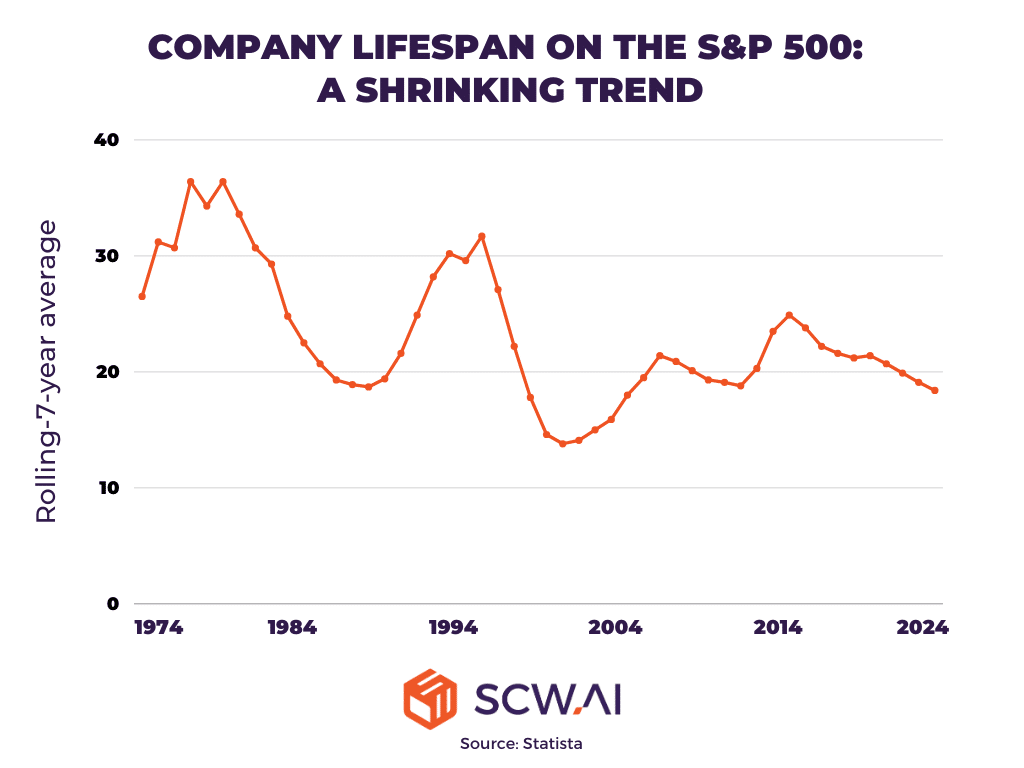
What is Agile Manufacturing?
Agile manufacturing involves adapting production and supply chain processes responsively to internal and external factors that influence business success. Internal factors can include cost minimization and quality excellence, while external factors may encompass a range of topics such as:
- Customer expectations and demand
- Competitors’ product catalogs, production methods, and efficiency
- Industry regulations
- Political and military conflicts and trade restrictions
- Nature related factors, including pandemics, disasters and climate change.
To be adaptive to change, manufacturers must first recognize that change is occurring. Therefore, being data-driven is a crucial aspect of agile manufacturing. Manufacturers need accurate and real-time information flow from their internal processes. While some lag is acceptable, timely information gathering and analysis of external factors are also essential.
After analyzing the data, manufacturers must take responsive actions. Agile production suggests breaking down ultimate tasks into smaller, manageable pieces, starting slowly, and setting measurable goals. This approach allows manufacturers to quickly adjust their strategies if initial efforts do not meet expectations, preventing excessive investment in unviable paths.
Relationship Between Lean Manufacturing and Agile Manufacturing
Lean manufacturing focuses on minimizing waste, reducing costs, and maximizing production quality and efficiency. In many respects, lean and agile manufacturing share common goals, as agile production often results in waste minimization. For example, to adapt to a demand surge, both agile and lean manufacturing strategies might aim to increase Overall Equipment Effectiveness (OEE). This target can be achieved through total productive maintenance practices that reduce unplanned equipment failures and improve line availability.
Similarly, just in time production is a demand-responsive strategy that fits the definition of agile manufacturing. But, it also minimizes inventory, aligning closely with lean manufacturing principles.
However, agile manufacturing also emphasizes flexibility and responsiveness to factors that do not prioritize waste minimization. A real life example is, during the COVID-19 pandemic, many of our clients utilized our Labor Tracker, which displays labor check-ins on realistic floor plans (see image below). During the pandemic, the labor tracking feature was not primarily utilized for waste minimization or productivity enhancement, but rather to adapt to the era’s circumstances where maintaining physical distance was essential for reducing spread contingency of illness.

Role of Digital Transformation in Agile Manufacturing
As we have already mentioned, agile manufacturing is only as effective as the quality and immediacy of your data. Interpreting this data to gain insights quickly, making data-supported decisions, and tracking outcomes are essential components. In this regard, digital transformation is a crucial tool that enhances industrial organizations’ agile manufacturing practices.
It is important to note that due to their nature, cloud manufacturing solutions support agile manufacturing initiatives further compared to low/no code or in-house tools. This is because cloud solutions are scalable according to the needs of businesses; manufacturers can upgrade or downgrade their subscriptions as needed. In line with the agile mentality, producers can start with a small implementation on a few lines and, once the success of the digital initiative is proven, expand to the whole factory.
6 Business Cases Where Manufacturers Need an Agile Mindset
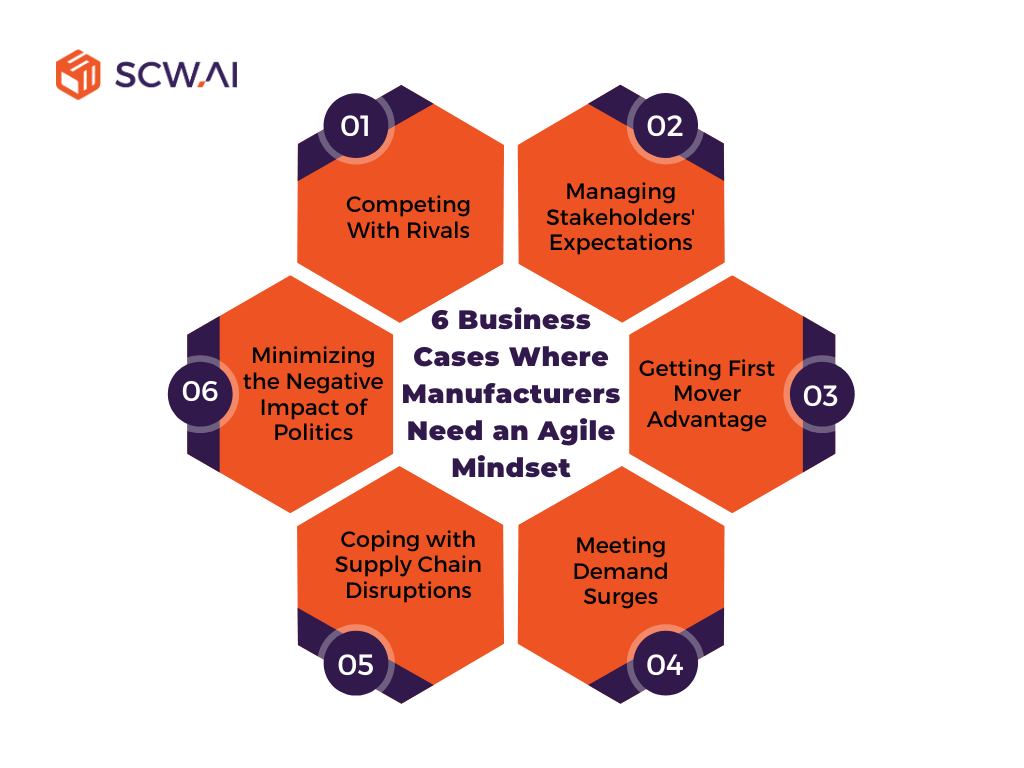
1. Competing With Rivals
A high level of competition gives customers more bargaining power regarding cost, quality, and service. To meet these higher expectations, manufacturers must continuously improve their internal processes. Various manufacturing KPIs can be targeted for improvement based on priorities, such as:
- Overall Equipment Effectiveness (OEE)
- Total Effective Equipment Performance (TEEP)
- Mean Time to Failure (MTTF)
- On-Time In-Full (OTIF)
- Schedule adherence and more.
For instance, consider a manufacturer aiming to improve its schedule adherence to enhance client satisfaction. To identify the root cause of delays, they compared target and actual durations for setup, run, and cleanup processes using a Schedule Adherence Report. Data analysis revealed that the primary area lagging behind schedule was run time (see image below).
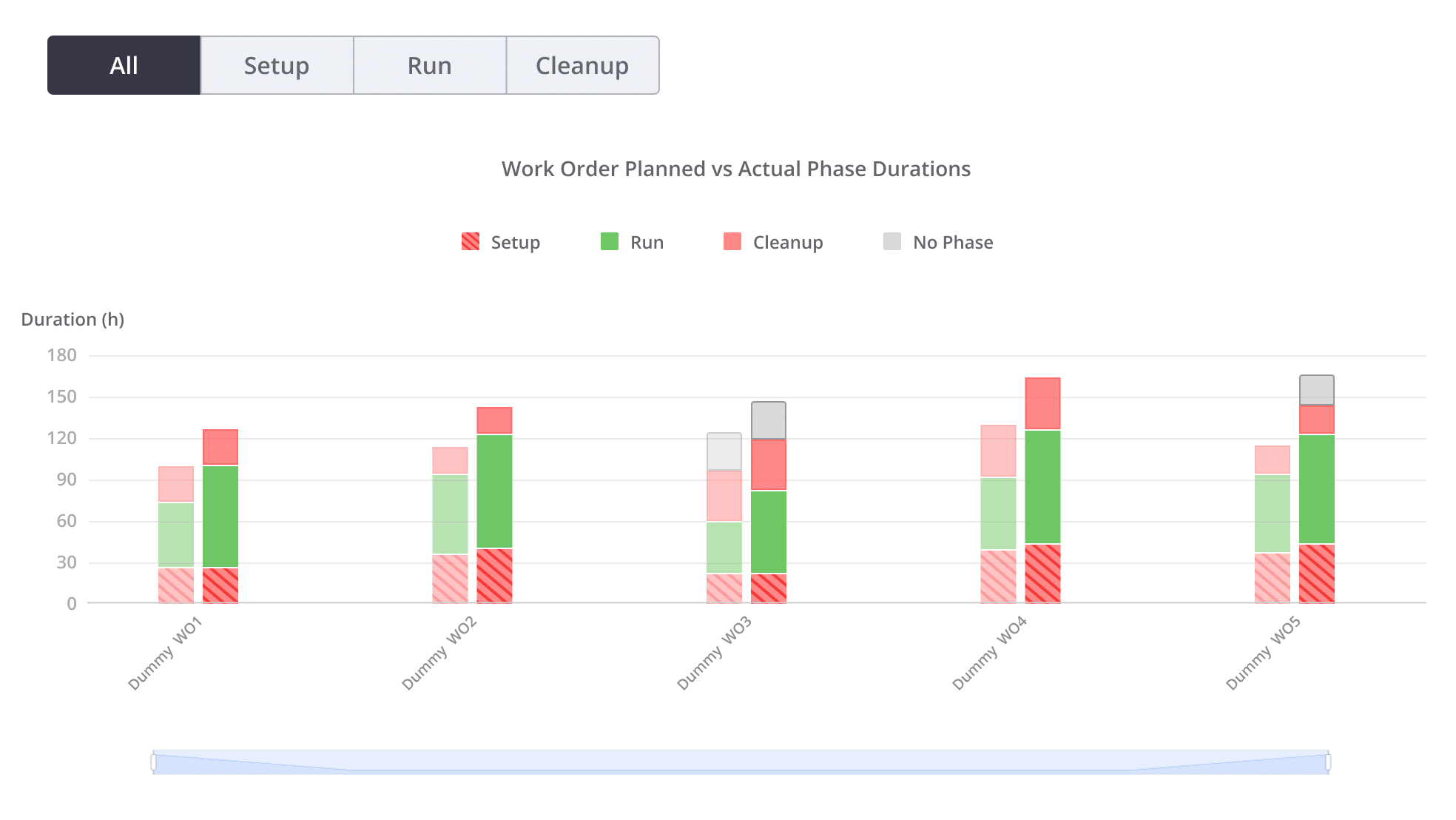
To improve run time performance, a training program could be organized focusing on correct equipment configuration and optimal production speeds for specific products. Additionally, ensuring production lines are clear of obstructions to minimize micro-stops is crucial. Manufacturers can easily develop such training programs using generative AI, incorporating example videos and illustrations. Following the training, the manufacturer would monitor the schedule adherence KPI to assess improvements and take further actions if necessary.
If you struggle to identify which manufacturing KPIs to monitor for your agile manufacturing initiatives, download our Manufacturing KPIs Handbook to discover over 60 metrics with formulas and explanations.
2. Managing Stakeholders' Expectations
Stakeholders can include financial investors, suppliers, partners, and clients, each with their own set of expectations and requirements. Agile manufacturing allows companies to be more responsive and adaptive to these varying demands, fostering transparency and trust. By continuously monitoring and analyzing data, manufacturers can proactively address concerns, communicate effectively, and make informed decisions that align with stakeholders’ interests.
For example, consider a scenario where the board of directors prioritizes minimizing work accidents and near-miss events. Utilizing an agile production approach, the manufacturer conducts daily SQCDP (Safety, Quality, Cost, Delivery, People) meetings and uses a digital board to track incidents. Data analysis reveals that wet floors are a major cause of near-miss events (see image below). Consequently, actions such as employee training on hazard awareness and the immediate placement of wet floor signs are assigned to responsible personnel.
3. Getting First-Mover Advantage
Having a first-mover advantage can be highly beneficial for manufacturers, allowing them to capture market share, set industry standards, and build strong brand recognition before competitors enter the field. Agile manufacturing empowers producers to innovate by enabling rapid development, testing, and deployment of new methods, thereby facilitating quick adaptation to evolving market demands and technological advancements.
A real-life example of this is seen in the pharmaceutical industry’s response to the COVID-19 pandemic. Pharmaceutical manufacturers leveraged agile manufacturing techniques to expedite the development and production of vaccines. Companies like Pfizer-BioNTech and Moderna utilized agile methodologies to streamline their research and production processes, leading to the development of effective vaccines in record time. This first-mover advantage not only yielded significant public health benefits but also elevated these companies to leadership positions in the pharmaceutical industry, increasing their market value by approximately tenfold compared to the pre-pandemic period.
4. Meeting Demand Surges
Due to seasonal changes, shifts in customer behavior, or other external factors, the demand for a particular product can increase significantly. While this surge in demand appears to be good news for manufacturers, it comes with challenges.
Firstly, manufacturers must ensure they have enough resources to meet the increased demand without losing market share to competitors. Secondly, they need to evaluate how long the demand surge will continue at its peak level and determine its plateau, which helps in deciding whether investments in further capacity and efficiency improvements will be worthwhile.
As a real-life example, Kenvue, a pharmaceutical manufacturer producing Tylenol, experienced a twelve-fold surge in demand for this product. After the initial peak, demand stabilized at around three times the pre-pandemic level.
As detailed by Michael Altman, VP of End-to-End US Supply Chain Operations at Kenvue, in the second episode of the SCW for Pharma podcast series, Kenvue utilized agile manufacturing to navigate this surge. They applied data analysis to forecast plateau demand, balanced production lines to handle the increased demand for Tylenol, and managed raw materials efficiently.
Below, you can find a video highlighting the main points of the Tylenol case study.
5. Coping with Supply Chain Disruptions
Supply chain disruptions, such as the global chip crisis, can significantly impact manufacturers. To cope with these disruptions, manufacturers can implement diversification strategies, such as sourcing from multiple suppliers and maintaining a flexible supply chain. Being data-driven is crucial in predicting potential threats and responding swiftly.
6. Minimizing the Negative Impact of International Relations
International relations can have profound effects on manufacturing operations, from trade restrictions to political conflicts. Manufacturers can mitigate these risks by diversifying their markets, suppliers, and production locations.
5 Agile Manufacturing Best Practices
In this section we will highlight 5 agile manufacturing best practices that help you to apply this production strategy.
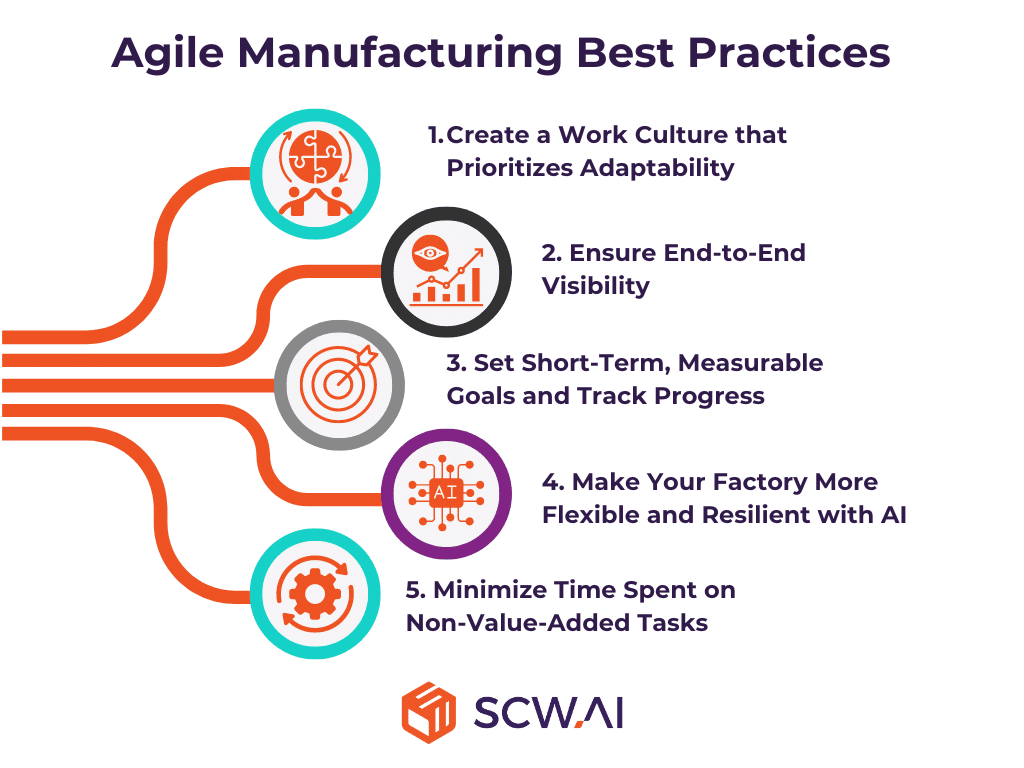
1. Create a Work Culture that Prioritizes Adaptability
Agile manufacturing revolves around defining problems and solving them by breaking them down into smaller, manageable parts. Therefore, fostering a work culture that prioritizes adaptability is essential. Central to this is the value placed on data. Each decision should be linked to an insight derived from data, ensuring that actions are informed and effective.
By embedding a data-driven mindset within the company culture, manufacturers can enhance their responsiveness and adaptability, enabling them to quickly identify and address issues, seize opportunities, and maintain a competitive edge.
2. Ensure End-to-End Visibility of Your Factory and Entire Supply Chain
To fully utilize agile manufacturing, it is crucial to collect information and data quickly and accurately. High-quality data empowers manufacturers to forecast upcoming opportunities and threats, enabling them to take appropriate actions.
The most critical step in collecting information is achieving maximum possible visibility across your shop floor, supply chain, and financial operations. This visibility helps detect bottlenecks and uncover hidden potentials. Industry 4.0 technologies, such as IoT, Modbus PLC, and OPC connections, are instrumental in gathering machine, labor, and environmental data. By leveraging these technologies, manufacturers can gain comprehensive insights into their operations, facilitating more informed decision-making and enhancing overall agility.
On the other hand, supply chain visibility can be improved via ERP tools, barcode technology and in some cases blockchain to send and receive data from upstream and downstream supply chains.
3. Set Short-Term, Measurable Goals and Track Progress Toward the Targets
A key principle of agile methodology in technology companies is to identify small tasks that can be completed within a week or two, resulting in measurable positive returns. This principle can be effectively applied in manufacturing through daily SQCDP (Safety, Quality, Cost, Delivery, People) meetings, where bottom-up information flow occurs and current problems are discussed. By digitizing this process and leveraging real-time data, these meetings can be transformed into agile meetings.
For instance, by examining the Digital SQCDP Board below, a manufacturer might determine a need to improve delivery times.
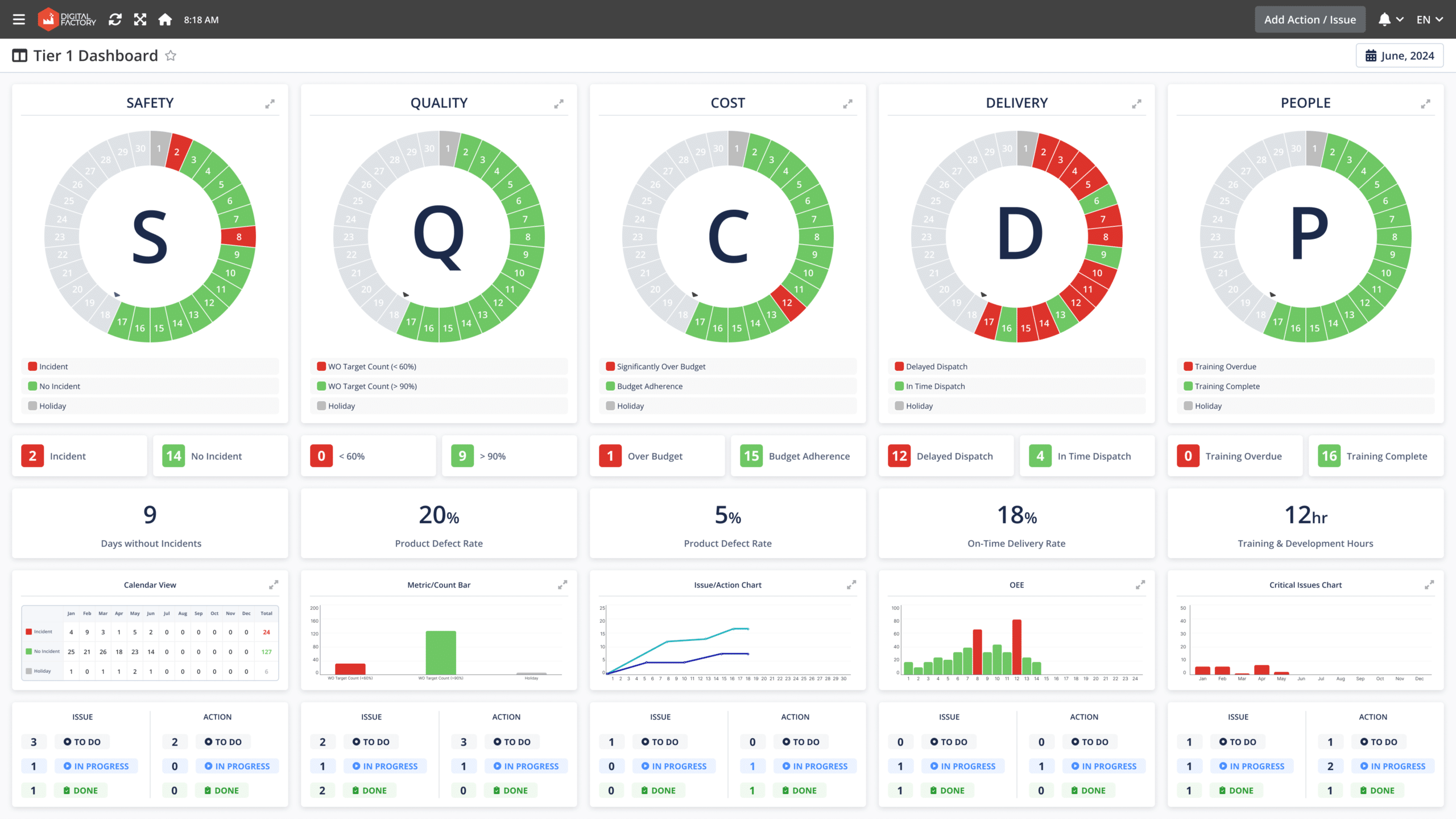
A further analysis using OEE Waterfall charts could reveal that changeover processes are causing significant time losses, leading to late delivery.
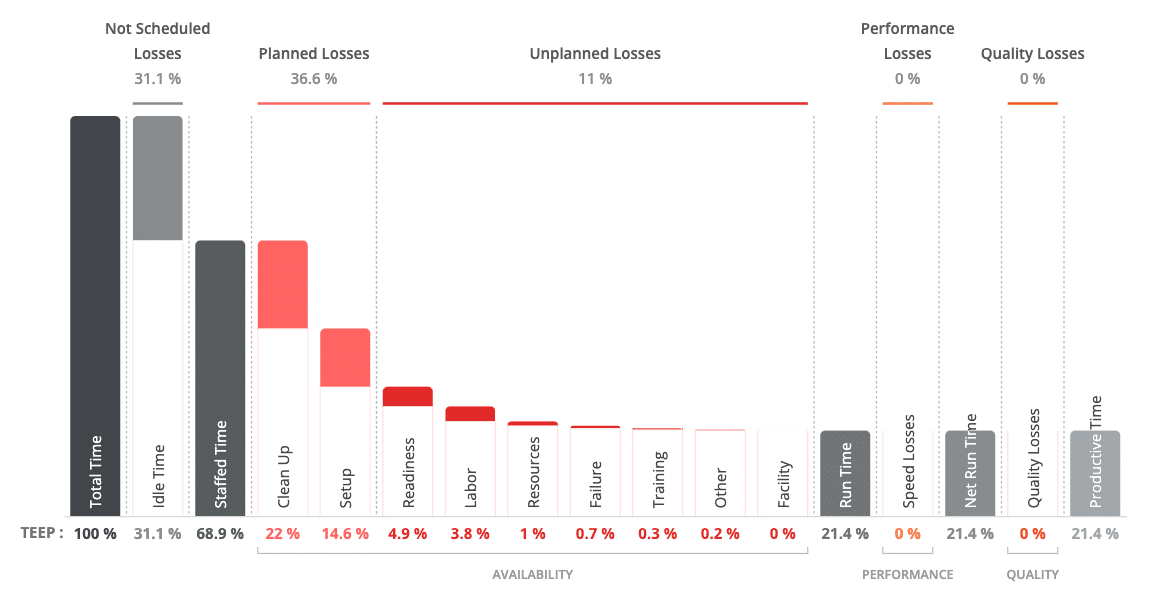
In such a case, setting short-term, measurable goals to streamline changeover procedures would be crucial. An example of a task that can be completed in two weeks to reduce changeover time is implementing a standardized setup checklist that is embedded on Digital Forms. This checklist would ensure that all necessary steps are completed in a consistent manner. By training staff on this new procedure and monitoring its implementation, manufacturers can quickly see improvements in changeover times.
4. Make Your Factory More Flexible and Resilient with Manufacturing AI Solutions
4.1 AI Demand Forecasting
As discussed by Tolga Kula and Evren Ozkaya, Ph.D., in the 5th episode of the SCW for Pharma podcast, AI can more accurately predict market demand compared to humans, enabling manufacturers to optimize inventory levels and production schedules. This leads to better resource allocation and improved responsiveness to market changes.
4.2 AI-Driven Flexible Job Shop Scheduling
AI models can orchestrate job shop scheduling with high efficiency within a short period of time (See Video Below). In addition AI models can solve job shop scheduling problems for various business cases such as:
- Just-in-time scheduling
- Changeover minimization
- OTIF maximization
- Cost minimization and many more.
4.3 Machine Learning-Driven Predictive Maintenance
Machine learning models analyze historical data to predict machine failures and notify maintenance teams in advance. This approach helps avoid unnecessary planned maintenance while reducing unplanned downtime and equipment failures. For example, SCW.AI’s ML driven predictive maintenance models demonstrate high accuracy in predicting machine failures, as shown in the image below.

To find out more AI applications for manufacturers read our Top 5 AI Use Cases in Manufacturing article.
5. Minimize Time Spent on Non-Value-Added Tasks
As mentioned in the video below by Brian Doel, Vice President of Clinical Supply Chain at Bristol Myers Squibb, many tasks in a business environment must be completed but do not directly add value. However, if the workforce spends excessive time on such tasks, they cannot focus on generating strategies to respond to changes in the business environment, rendering agile production initiatives less effective.
The good news is that numerous factory automation technologies can streamline various manufacturing operations. For instance, paperless manufacturing solutions like Digital Logbooks reduce the time required for data entry and task approval. Manufacturing analytics automates data analysis, providing actionable insights instantly. Additionally, advanced planning and scheduling systems automate various tasks, from production capacity utilization to labor scheduling. These technologies free up valuable time, enabling the workforce to concentrate on strategic initiatives and enhancing overall agility.
Start Agile Production with SCW.AI
SCW.AI assists manufacturers in achieving end-to-end visibility, enhanced flexibility, and AI-driven automation through its cloud-based Digital Factory Platform. This platform ensures fully digitized and agile factories with modules that address every facet of production:
- To ask your further questions about agile production, please contact us.
To see how Digital Factory Platform helps you in the endeavor of agile manufacturing, book a demo now.



